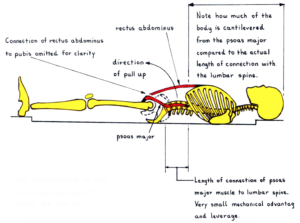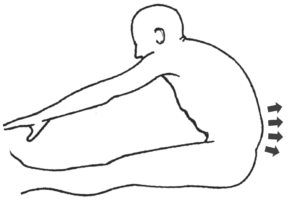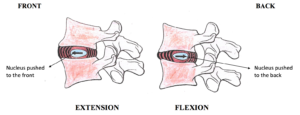The Danger to the Lumbar Spine while Performing Sit-Ups
The Danger to the Lumbar Spine
while Performing Sit-Ups
The Sit-Ups Fallacy
Note: Read in conjunction with the article, Fitness and Misuse
I have reproduced from the book “Going Mental” my account of what happens to the lumbar spine during sit-ups, and have added in this article, further detailed illustrations showing the danger to the intervertebral discs.
Another pointless exercise is “sit-ups”, the one where you lie flat on the back with the legs outstretched and then haul the torso up to the sitting position, keeping the legs on the floor.
As I said in my book, Going mental, the only muscle that runs up into the back from the legs is the psoas major, up as high as the 1st lumbar vertebra. This muscle must perform almost entirely by itself, the enormous feat of pulling the torso up to the vertical and beyond. It will be helped a little by the iliacus muscle, but this muscle does not run above the iliac crest of the pelvis and has, therefore, even less mechanical advantage.
You can see from the picture below, the disparity between the short length of contact the psoas major has with the lumbar spine and the long cantilevered length of the torso, head and arms, whose weight it has to lift.

Figure 1: Sit-Ups Fallacy
There is a common mistaken idea that the rectus abdominus pulls the torso up to the vertical, but it cannot do this because it does not run over the hip joint and does not even connect to the legs. All it succeeds in doing is pulling the rib-cage closer to the pelvis, which is like trying to lift yourself up by your own shoelaces.
It is interesting to see that, in doing this exercise, the hands are placed behind the head, which makes the situation worse because the further you take the arms up, the more you increase the bending moment of force from the cantilevered torso, thus throwing even more load into the lumbar spine.
People perform this exercise under the illusion that they are pulling the torso up with the arms, but again, this is like trying to lift yourself up by your own shoelaces. This yanking of the head forwards is increased as the person starts to tire, because the arms are not yet as tired as the lifting muscles. The neck is also bent forwards excessively as the person “goes for it” with gritted teeth and much grunting, as they are tiring and this can cause a slipped disc in the neck.
If you look closely at someone doing this exercise, you will see that the first thing that occurs is a distinct, detrimental arching of the lumbar spine, as the psoas major contracts violently to haul the torso up. This can cause damage to the spine.
The next thing that happens is the head and rib-cage are brought, by the rectus abdominus, nearer to the fulcrum point – the hip joints – thus slightly reducing the cantilever effect. But, remembering that the rectus abdominus cannot lift the torso, this excessive arching of the lumbar spine occurs all the way through the movement, apart from the few last centimetres. The person then usually bends the torso further than the vertical and the lumbar spine is curved harmfully in the opposite direction.
 Figure 2: Nucleus Pulposus pushed to the back
Figure 2: Nucleus Pulposus pushed to the back
The same effect occurs in the movement from the vertical back to the horizontal, because the psoas major has to let the torso out, so to speak, rather like letting a boat out with a rope as it is being pulled away by the current. This means that for most of this movement, the lumbar spine is arched excessively until the back approaches the floor, where it bends in the opposite direction.
A further point of note; most people cannot perform this exercise without putting the legs under a bench or something, or having a friend to hold them down; proof positive that this exercise is unnatural. It is also a prime example of expending a tremendous amount of misplaced, wasted energy. If you repeat it often enough, you could cause irreversible damage to the spine.
If most exercise are not only fruitless, but also dangerous, then you may ask, “How am I to stay fit? What should I do?”
Well, the best natural exercise is walking. People who walk are just as fit as people who run. Jogging is not as good as running fast, because in jogging, people usually adopt a sluggish gait halfway between walking and a dynamic running gait. Running should be done as dynamically but as easily as possible. It is better to sprint 100m then walk 100m, and repeat the sequence as often as you can comfortably manage. No trying too hard, no tightening up, take it easy. If you love to dance or play a sport, then do it, but always remember the danger of overdoing it.

Figure 3: Nucleus Pulposus during Extension and Flexion
Inside each of the cartilaginous discs is a bubble of gel-like fluid called the nucleus pulposus. This combination of the discs and the fluid give the spine its resilience.
In the alternating flexing and extending of the spine in sit-ups, flexion will push the nucleus to the back of the disc, and in extension, will push the nucleus to the front.
If sit-ups are repeated often enough, the nucleus will eventually rupture the walls of the disc and the fluid will leak into the spinal canal and other places, causing problems of harmful damage and pain.
This article was first published in Going Mental by Daniel McGowan. You can download the PDF of this book for free here: FREE DOWNLOAD